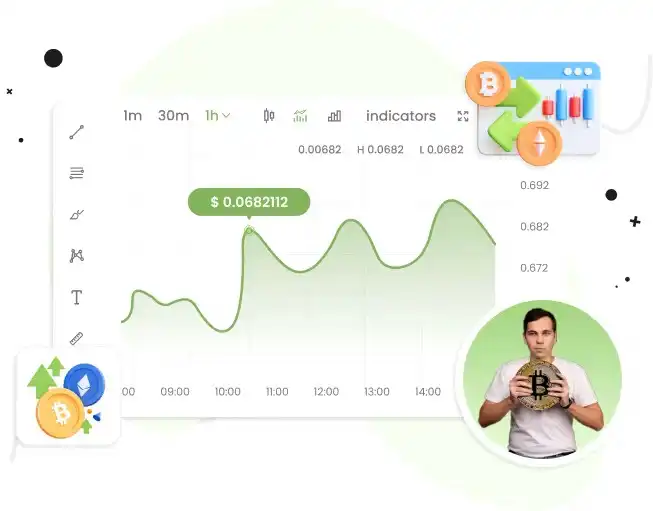The cryptocurrency landscape has evolved dramatically over the last decade—from being a fringe financial experiment to becoming a pillar of global digital finance. As we enter the second half of 2025, market conditions, technology maturity, and user behavior trends are converging to make this the ideal time for entrepreneurs and businesses to launch their own crypto exchanges.
This article dives into the key reasons why 2025 is uniquely positioned for exchange startups to thrive, supported by recent statistics, market movements, and development opportunities. If you’ve been waiting for the right time, the time is now.

1. Explosive Market Growth and Trading Volume
2025 has already witnessed a surge in crypto adoption. According to recent reports from Chainalysis and CoinMarketCap:
- Daily global crypto trading volume has consistently exceeded $120 billion.
- Over 500 million crypto users are active globally, up from 420 million in 2024.
- Altcoin and DeFi usage continues to push the demand for more localized and niche exchanges.
This creates a lucrative landscape for launching platforms tailored to specific regions, assets, or compliance requirements. With trading activity at an all-time high, a well-built exchange with the right features can capture massive market share, even in competitive environments.
2. Regulatory Clarity is Improving Globally
In the past, regulatory uncertainty was one of the major roadblocks to launching a crypto exchange. But 2025 has shown significant progress:
- MiCA (Markets in Crypto Assets) regulation in Europe is now in effect.
- The U.S. SEC and CFTC are working toward clearer definitions for digital assets.
- Many Asian countries, including Singapore and Japan, are encouraging compliant exchange startups.
This shift has opened doors for entrepreneurs to legally operate in jurisdictions with full licensing, adding legitimacy and trust to their platforms from day one.
3. Technology Maturity & White Label Solutions
Developing a crypto exchange from scratch was once expensive and time-consuming. Today, that’s no longer the case.
Companies like Pixel Web Solutions, a leading crypto exchange development company, have helped reduce the development cycle dramatically by offering:
- White-label crypto exchange software with customizable modules
- Pre-built trading engines supporting spot, margin, and derivatives trading
- Integrated security features including 2FA, anti-phishing, and cold wallets
- KYC/AML modules and multi-chain wallet support
This allows founders to go from idea to market in under 60 days, saving on both cost and complexity.
“We’ve seen a 3X increase in entrepreneurs building their own exchanges since Q4 2024,” says a senior blockchain architect at Pixel Web Solutions. “With the tech stack matured and security standards tightened, 2025 is the safest time to enter the space.”
4. Demand for Region-Specific and Niche Exchanges
Global giants like Binance and Coinbase dominate much of the mainstream market. But their one-size-fits-all approach leaves gaps in:
- Local fiat onboarding
- Regional compliance
- Language preferences
- Support for local tokens
This presents a perfect opportunity for entrepreneurs to launch regionally optimized crypto exchanges, especially in emerging markets across Africa, Southeast Asia, and Latin America.
Additionally, there’s growing demand for niche exchanges focused on:
- Green/eco-friendly tokens
- DeFi asset trading
- Web3 utility tokens
- NFT-backed asset trading
Custom exchanges tailored to a specific user base, theme, or asset class can scale quickly without competing directly with mainstream giants.
5. Institutional Interest is Driving Trust and Adoption
Institutional adoption is at its peak in 2025:
- BlackRock, Fidelity, and Citadel have launched crypto ETFs.
- Visa and Mastercard now support direct crypto payments.
- Major banks are integrating blockchain rails for real-time settlement.
This trust ripple is pushing more everyday users into the crypto ecosystem—and they need exchanges they can rely on.
With a robust backend and a well-designed front-end, new exchange players can earn credibility quickly by offering regulated access, customer service, and local integration.
6. Opportunities in AI and Automated Trading Integration
Another 2025 trend is the integration of AI in trading engines. Traders are demanding:
- Automated bots
- Predictive analytics
- Smart order routing
- Sentiment-based price alerts
New crypto exchanges that integrate AI-based trading tools can position themselves as next-generation platforms. Companies are already incorporating AI and ML into the backend of their exchange offerings, giving clients a competitive edge.
7. Global Payment Integration Is Easier Than Ever
One of the biggest friction points in crypto exchanges used to be fiat on/off-ramping. But with providers like Stripe, MoonPay, and Transak offering global support, it’s now easier to:
- Accept fiat deposits in 100+ currencies
- Support UPI, cards, wire transfers, and e-wallets
- Enable instant withdrawals to bank accounts
Modern exchanges can now seamlessly integrate these services, removing a major entry barrier for retail users.
Final Thoughts: Don’t Miss the 2025 Window
If you’re thinking about entering the crypto space, 2025 offers a rare combination of growth, clarity, and maturity. Unlike in the early days, you now have access to:
- Proven development partners
- Streamlined legal frameworks
- Tech stacks that are secure and scalable
- A fast-growing, increasingly mainstream user base
Whether you’re a startup, fintech company, or entrepreneur with a vision, building your own crypto exchange is no longer a moonshot—it’s a calculated, attainable business opportunity.




